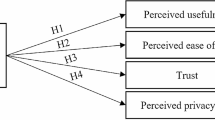Abstract
In this paper we show how audience expectations towards what is presented on public displays can correlate with their attention towards these displays. Similar to the effect of Banner Blindness on the Web, displays for which users expect uninteresting content (e.g. advertisements) are often ignored. We investigate this effect in two studies. In the first, interviews with 91 users at 11 different public displays revealed that for most public displays, the audience expects boring advertisements and so ignores the displays. This was exemplified by the inclusion of two of our own displays. One, the iDisplay, which showed information for students, was looked at more often than the other (MobiDiC) which showed coupons for shops. In a second study, we conducted repertory grid interviews with 17 users to identify the dimensions that users believe to influence whether they look at public displays. We propose possible solutions to overcome this “Display Blindness” and increase audience attention towards public displays.
Preview
Unable to display preview. Download preview PDF.
Similar content being viewed by others
References
Burke, M., Hornof, A., Nilsen, E., Gorman, N.: High-cost banner blindness: Ads increase perceived workload, hinder visual search, and are forgotten. ACM Trans. Comput.-Hum. Interact. 12(4), 423–445 (2005)
Eppler, M.J., Mengis, J.: The concept of information overload: A review of literature from organization science, accounting, marketing, mis, and related disciplines. The Information Society 20, 325 (2004)
Honey, P.: The repertory grid in action. Industrial and Commercial Training 11, 452–459 (1979)
Huang, E., Koster, A., Borchers, J.: Overcoming assumptions and uncovering practices: When does the public really look at public displays? In: Indulska, J., Patterson, D.J., Rodden, T., Ott, M. (eds.) Pervasive 2008. LNCS, vol. 5013, pp. 228–243. Springer, Heidelberg (2008)
Jankowicz, D.: The Easy Guide to Repertory Grids, 1st edn. Wiley, Chichester (2003)
Milgram, S.: The experience of living in cities. Science, 1461–1468 (March 13, 1970)
Müller, J., Krüger, A.: How much to bid in digital signage advertising auctions? In: Adjunct proceedings of Pervasive 2007 (2007)
Müller, J., Paczkowski, O., Krüger, A.: Situated public news and reminder displays. In: Schiele, B., Dey, A.K., Gellersen, H., de Ruyter, B., Tscheligi, M., Wichert, R., Aarts, E., Buchmann, A. (eds.) AmI 2007. LNCS, vol. 4794, pp. 248–265. Springer, Heidelberg (2007)
Author information
Authors and Affiliations
Editor information
Editors and Affiliations
Rights and permissions
Copyright information
© 2009 Springer-Verlag Berlin Heidelberg
About this paper
Cite this paper
Müller, J. et al. (2009). Display Blindness: The Effect of Expectations on Attention towards Digital Signage. In: Tokuda, H., Beigl, M., Friday, A., Brush, A.J.B., Tobe, Y. (eds) Pervasive Computing. Pervasive 2009. Lecture Notes in Computer Science, vol 5538. Springer, Berlin, Heidelberg. https://doi.org/10.1007/978-3-642-01516-8_1
Download citation
DOI: https://doi.org/10.1007/978-3-642-01516-8_1
Publisher Name: Springer, Berlin, Heidelberg
Print ISBN: 978-3-642-01515-1
Online ISBN: 978-3-642-01516-8
eBook Packages: Computer ScienceComputer Science (R0)




